09-24-2017, 07:53 PM
(This post was last modified: 09-24-2017, 08:00 PM by danbrotherston.)
About two weeks ago, I went biking around Mont-Tremblant Quebec. I've biked there before, every time I'm amazed at how pleasant biking is in the area.
Mont-Tremblant is probably very good for Quebec in general, given that they host the Iron Man, which includes a long bike race, but I get the impression, that many places in Quebec are very very good for biking (not just in Montreal).
There are a substantial number of trails, most of which are paved (except for the Petit-Train-du-Nord outside of Mont-Tremblant down to Montreal, and up to Labelle). You can reach pretty much all of the municipalities within the Mont-Tremblant area by bike pretty comfortably, as well as most of the major municipalities along the Autoroute Laurentides via the Petite-Train-du-Nord, and the ones I've seen have some bike infra.
And the cycling friendliness is not restricted to trails. Many roads have a great deal of effort put into being very cycling friendly. Some roads have wide shoulders, but others have very prominent signage, and restricted speeds. Within villages this is especially apparent and 30km/h zones are very common. Moreover, there seems to be a big effort put into continuity of routes. Signage isn't so clear for destinations, but I didn't encounter any situations where I had to look for the continuation of a trail.
Pedestrian crossings are also well marked and frequent. Additionally, the major highway in the area is bypassed around towns, which means most of the village centres don't have a huge amount of traffic, and when added to the 30km/h the area is very pleasant to be a pedestrian or cyclist in.
From the people I spoke too (or Tess spoke French too) on our trip, much of this is as a result of provincial funding. This matched what I saw which showed provincial roads to both have good infrastructure, and as not serving as an impediment to cycling. This is a substantial shift from Ontario, where the province seems to be a substantial obstacle to cycling, and municipalities have largely taken the lead. Perhaps this will change with the new CycleON policies.
I'm also told there is a lot of mountain biking, and we saw some evidence of this, but as it is not in my skillset, I didn't partake can cannot review.
It is worth noting, the area is still very car oriented. The primary target of this infrastructure appears to be recreational cyclists. While I can totally imagine staying there with only a bike, I suspect most people still have cars. I saw very many vehicles with bikes on the back. The areas are still fairly far apart. Although, given the area mostly is a recreational area, I guess this is not surprising.
Our routes:
https://drive.google.com/open?id=1sN-QH9...sp=sharing
Here's an example of trails in the Mont-Tremblant area. While cycling might be reasonably good in Quebec, this is truly exemplary. Wide (at least 4 meters, more around corners), paved trail with good signage, and, *gasp* substantial blasting (and filling) to level the trail somewhat. Given it's a mountainous area, there is still a lot of climbing, but this seems like a huge luxurious expense for cycling infrastructure. And keep in mind, this particular trail is not a rail trail. This blasting was done just for the trail.
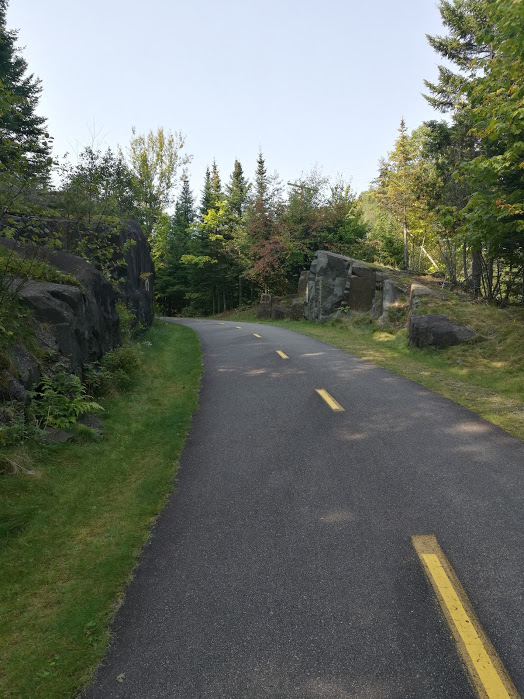
I'm not sure if this sign is intended to convey winter biking routes or not.
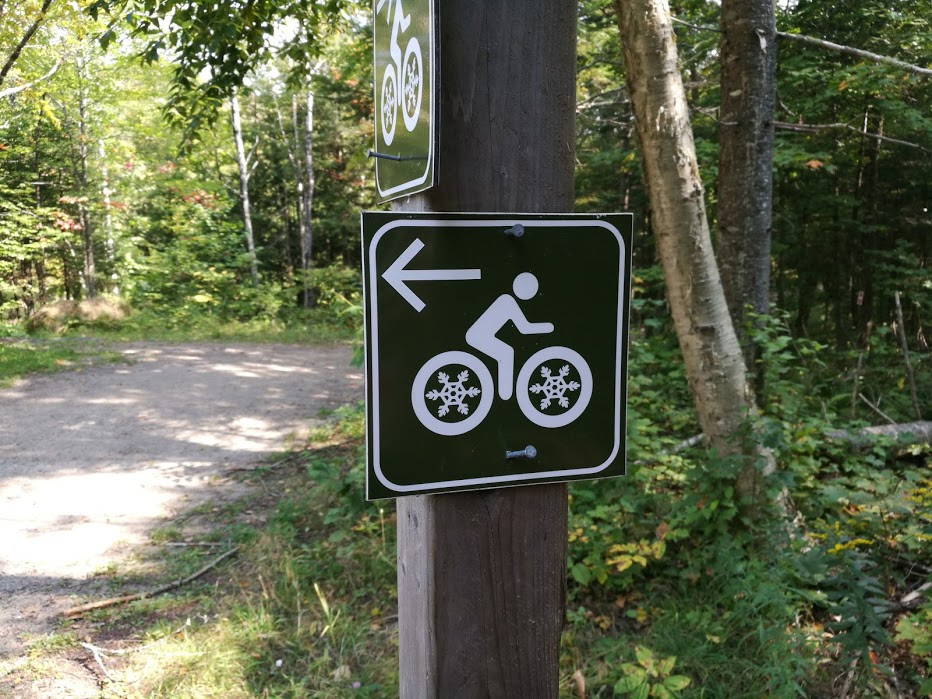
This image is from the waterfront, which is another 30km/h zone, with many pedestrian crossings (like the one pictured), where pedestrians have the right of way (legally and in practice) there is a sign marking it as well. On faster wider roads, the crossing will be marked with a sign in the middle of the road as well. The blue line is marking the course for the Iron Man.
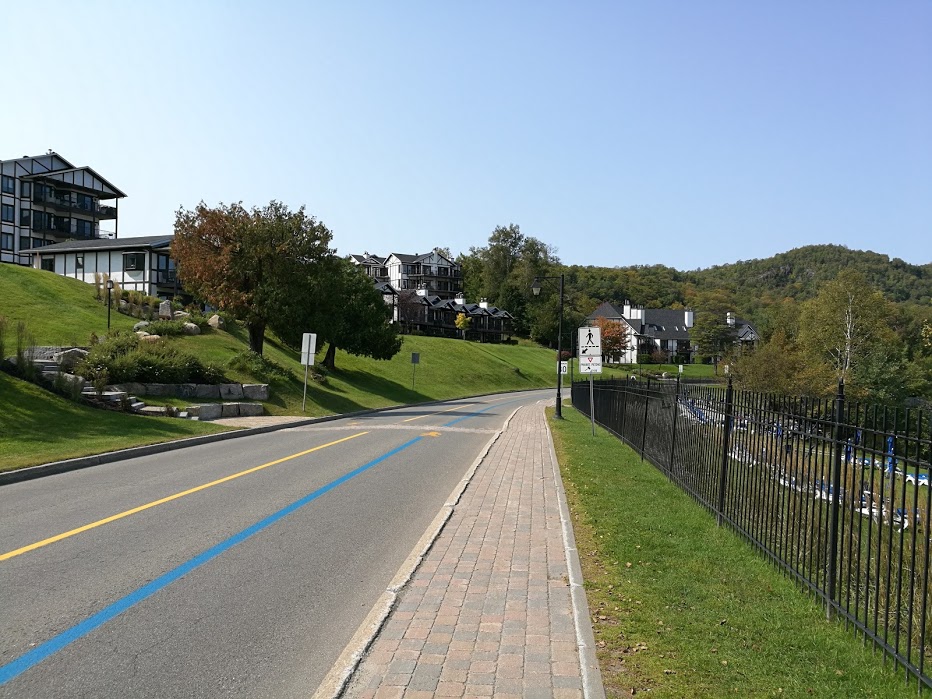
Here is a substantial bike repair/washing station near the mountain biking skills park. There's also garbage and recycling (which are also very common in the municipality). I thought the washing station was interesting as well.
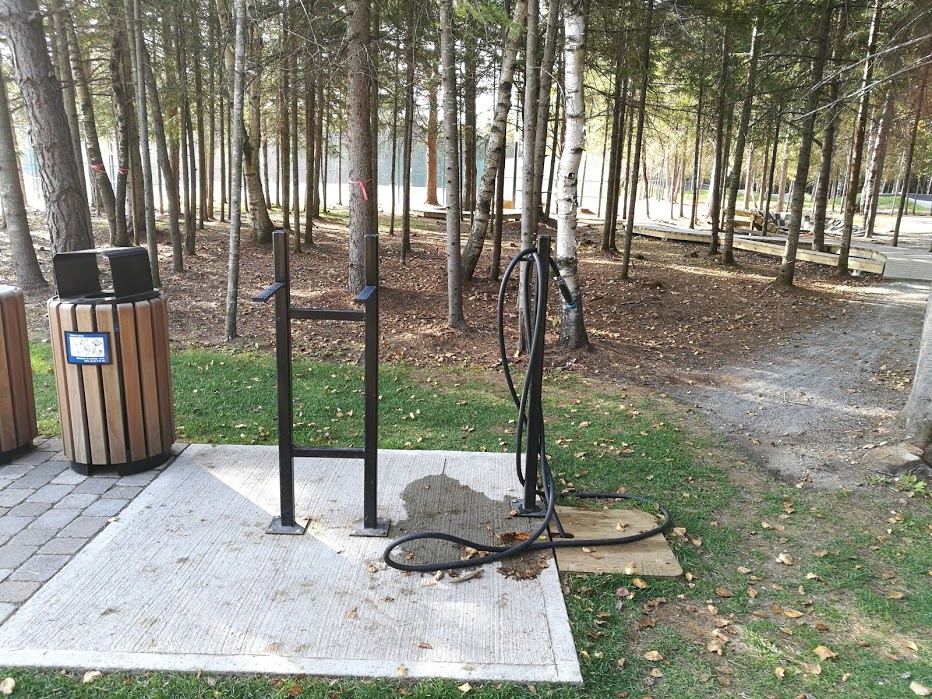
Mont-Tremblant had these signs in several places, single file is a bit disappointing, but limiting groups to *only* 15 is huge, and requiring 1.5 meters when passing also beats Ontario.
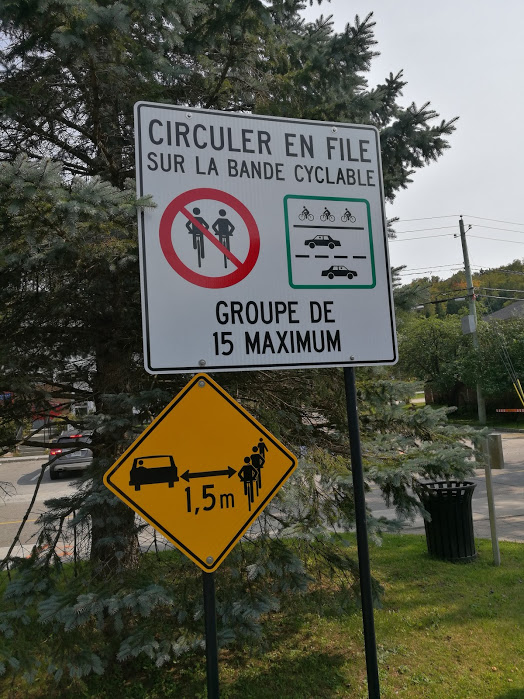
Mont-Tremblant is probably very good for Quebec in general, given that they host the Iron Man, which includes a long bike race, but I get the impression, that many places in Quebec are very very good for biking (not just in Montreal).
There are a substantial number of trails, most of which are paved (except for the Petit-Train-du-Nord outside of Mont-Tremblant down to Montreal, and up to Labelle). You can reach pretty much all of the municipalities within the Mont-Tremblant area by bike pretty comfortably, as well as most of the major municipalities along the Autoroute Laurentides via the Petite-Train-du-Nord, and the ones I've seen have some bike infra.
And the cycling friendliness is not restricted to trails. Many roads have a great deal of effort put into being very cycling friendly. Some roads have wide shoulders, but others have very prominent signage, and restricted speeds. Within villages this is especially apparent and 30km/h zones are very common. Moreover, there seems to be a big effort put into continuity of routes. Signage isn't so clear for destinations, but I didn't encounter any situations where I had to look for the continuation of a trail.
Pedestrian crossings are also well marked and frequent. Additionally, the major highway in the area is bypassed around towns, which means most of the village centres don't have a huge amount of traffic, and when added to the 30km/h the area is very pleasant to be a pedestrian or cyclist in.
From the people I spoke too (or Tess spoke French too) on our trip, much of this is as a result of provincial funding. This matched what I saw which showed provincial roads to both have good infrastructure, and as not serving as an impediment to cycling. This is a substantial shift from Ontario, where the province seems to be a substantial obstacle to cycling, and municipalities have largely taken the lead. Perhaps this will change with the new CycleON policies.
I'm also told there is a lot of mountain biking, and we saw some evidence of this, but as it is not in my skillset, I didn't partake can cannot review.
It is worth noting, the area is still very car oriented. The primary target of this infrastructure appears to be recreational cyclists. While I can totally imagine staying there with only a bike, I suspect most people still have cars. I saw very many vehicles with bikes on the back. The areas are still fairly far apart. Although, given the area mostly is a recreational area, I guess this is not surprising.
Our routes:
https://drive.google.com/open?id=1sN-QH9...sp=sharing
Here's an example of trails in the Mont-Tremblant area. While cycling might be reasonably good in Quebec, this is truly exemplary. Wide (at least 4 meters, more around corners), paved trail with good signage, and, *gasp* substantial blasting (and filling) to level the trail somewhat. Given it's a mountainous area, there is still a lot of climbing, but this seems like a huge luxurious expense for cycling infrastructure. And keep in mind, this particular trail is not a rail trail. This blasting was done just for the trail.
I'm not sure if this sign is intended to convey winter biking routes or not.
This image is from the waterfront, which is another 30km/h zone, with many pedestrian crossings (like the one pictured), where pedestrians have the right of way (legally and in practice) there is a sign marking it as well. On faster wider roads, the crossing will be marked with a sign in the middle of the road as well. The blue line is marking the course for the Iron Man.
Here is a substantial bike repair/washing station near the mountain biking skills park. There's also garbage and recycling (which are also very common in the municipality). I thought the washing station was interesting as well.
Mont-Tremblant had these signs in several places, single file is a bit disappointing, but limiting groups to *only* 15 is huge, and requiring 1.5 meters when passing also beats Ontario.



